Home > Research > Research Results > Research Results 2017 > Proposing a method to determine the sex of a plant based on the pollen count of the soil
Update:August 7, 2017
Main content starts here.
Proposing a method to determine the sex of a plant based on the pollen count of the soil
| Article title |
The use of soil pollen to determine the sex of overhead individuals of a temperate dioecious shrub |
||
|---|---|---|---|
| Author (affiliation) |
Anna Sugiyama (a&b), Koji Shichi (c), Takashi Masaki (d), Stephen P. Hubbell (a&e) (a) University of California, Los Angeles, U.S.A. (c) Shikoku Research Center, FFPRI, Kochi, Japan. (d) Research Planning and Coordination Department, FFPRI, Tsukuba, Ibaraki, Japan. (e) Smithsonian Tropical Research Institute, Balboa, Ancón, Republic of Panamá. |
||
| Publication Journal |
American Journal of Botany, 104(4):632-638, April 2017, DOI: 10.3732/ajb.1600407( External link ) |
||
| Content introduction |
As in humans, dioecious plants have male and female plants that are distinct from each other. Thus, the determination of their sex is a prerequisite because only female plants are needed when fruit and seeds have to be collected. However, unlike humans, it is impossible to determine the sex of plants based on their appearance alone. Determining the sex of the plant is possible only during the stages of blossoming or fruit-bearing. Accordingly, the sexing of species that bloom or fructify only once in several years is extremely difficult. In dioecious plants, only male plants produce pollen, most of which falls onto the soil underneath the plant that has produced it. Although the morphology of the pollen varies depending on the species, most types accumulate in the soil for an extended period without being decomposed. Consequently, when a plot of soil beneath a male plant is compared with that beneath a female plant, it is exceedingly likely that large quantities of pollen specific to only the male plant of that species are detected. In the present study, we collected soil samples from plots beneath male and female plants of Aucuba japonica, a dioecious shrub species, and compared the number of pollen particles in those samples (picture). We found that plots beneath the male plant contained significantly higher numbers of pollen particles of Aucuba japonica than those beneath female plants (figure). To the best of our knowledge, this study demonstrates, for the first time in the world, that counting pollen particles in the soil is conducive to determining the sex of dioecious plants. These results suggest that the number of pollens in the soil beneath dioecious plants is an excellent indicator that enables sexing of more species outside the flowering and fructification periods.
|
Copyright © Forest Research and Management Organization. All rights reserved.


